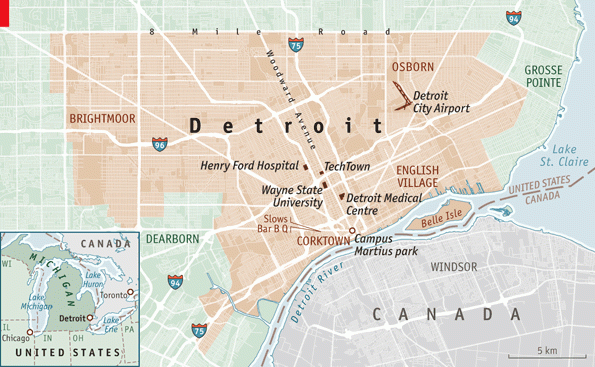The 2010 Census reveals that Detroit's population is approaching the 1910's level. Of the City's 714,000 residents, 83% are black and nearly 40% live in poverty. With virtually every statistic going against its favor, can Motown make a comeback?
That Detroit faces "a demographic catastrophe [...] without parallel in the developed world" is anticipated. For starters, the City has over 60,000 vacant homes, dismal property values, stratospheric crime rates, and a dysfunctional school system. On the last point, a mere "11% of Detroiters aged between 25 and 34 has a college degree; in Seattle, the equivalent figure is 63%," according to The Economist.
"Yet despite all the gloom, there is a bit of a sense that things might just be starting to turn, and the reason is simple: Detroit is now incredibly cheap. And that has drawn some admittedly rather pioneering types back into town," says the article.
To that effect, Mayor Dave Bing "would like to concentrate his citizens, boosting the population density in areas that are still economically viable, while encouraging people to move out of districts that are not." The proposed M1 light-rail system "will run along Woodward Avenue, the main axis of Detroit's planned redevelopment. With the river and downtown at one end, the 'Woodward Corridor' stretches north to one of the other great hopes for the city, a cluster of universities and business parks."
FULL STORY: The parable of Detroit: So cheap, there’s hope

Planetizen Federal Action Tracker
A weekly monitor of how Trump’s orders and actions are impacting planners and planning in America.

Chicago’s Ghost Rails
Just beneath the surface of the modern city lie the remnants of its expansive early 20th-century streetcar system.

Amtrak Cutting Jobs, Funding to High-Speed Rail
The agency plans to cut 10 percent of its workforce and has confirmed it will not fund new high-speed rail projects.

Ohio Forces Data Centers to Prepay for Power
Utilities are calling on states to hold data center operators responsible for new energy demands to prevent leaving consumers on the hook for their bills.

MARTA CEO Steps Down Amid Citizenship Concerns
MARTA’s board announced Thursday that its chief, who is from Canada, is resigning due to questions about his immigration status.

Silicon Valley ‘Bike Superhighway’ Awarded $14M State Grant
A Caltrans grant brings the 10-mile Central Bikeway project connecting Santa Clara and East San Jose closer to fruition.
Urban Design for Planners 1: Software Tools
This six-course series explores essential urban design concepts using open source software and equips planners with the tools they need to participate fully in the urban design process.
Planning for Universal Design
Learn the tools for implementing Universal Design in planning regulations.
Caltrans
City of Fort Worth
Mpact (founded as Rail~Volution)
City of Camden Redevelopment Agency
City of Astoria
City of Portland
City of Laramie






























